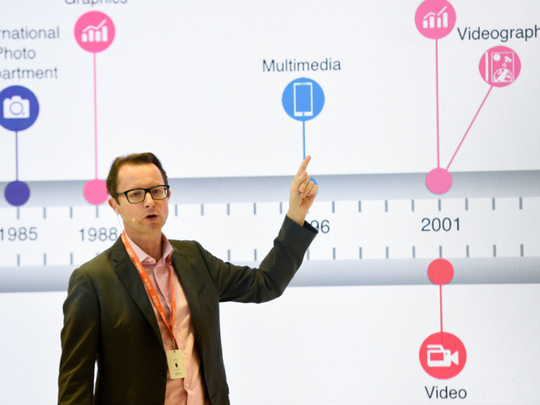
Dubai: Imagery and visual content are totally transforming the way stories are told driving the media away from linear words, said a prominent international journalist at the 17th Arab Media Forum.
Sharing his insights into how technology and social media have changed the way information is gathered and presented, Phil Chetwynd, global editor-in-chief, Agence France Presse (AFP), said the world’s traditional media landscape is being rapidly remodelled.
“Social media is dominating everything that we do. The conversation is loud, difficult to control and driven by image, not by word.”
Speaking at a session titled ‘Visuals: Changing the World and Shaping the Future,’ Chetwynd outlined the story of the news media’s tilt towards visual journalism.
“Everything we have done since 1985 is more visually driven and away from the words. Culminating in the last few years into new formats like live videos, interactive graphics, 360 degree visuals as well as data visualisation,” said Chetwynd, who leads a multinational group of 1,600 journalists working from all corners of the world.
He added that the intense move towards the image has had an enormous impact in the way news is gathered and the way news is presented.
“More stories are now told around images and videos. People are more interested now in the visual news. This has also brought into play the user-generated content or eyewitness media. We have entered a whole new world, where there is an eyewitness to every event. And pictures and videos captured by citizen journalists dominate the news in many cases,” he said.
Pointing out recent events where the images and videos captured by eyewitnesses at major events went viral, he said: “Many of the pictures of the major global events like the war in Syria, circulating in the social media as well as in the new portals, are not taken by journalists but by people who until a few years ago were not journalists and these images speak for themselves.”
He highlighted that technology has opened up new avenues and perspectives.
“We now have the capacity to tell stories in ways that were not possible before. We now reach people that we would never reach before. Everything and every event is now well documented, which was not the case before,” he said.
However, Chetwynd also cautioned that the image-driven, social media-dominated journalism has offered more opportunities for fake news and manipulation of content to infiltrate the online conservation.
“Eyewitness-generated content and social media expose us to the greater risk of fake news and this where the role of journalists and media establishments become more important. Now there is a greater need to verify the content, and media organisations and individuals should have a stringent process in place and no content should be shared if there is even a shred of doubt,” said Chetwynd.











